-

大班英语教案:Green grass is on the ground.
会唱:< Baaing, baaing,peeper shee gt; Teaching tool:Some cards、tape Teaching Procedures Teacher Student 1st.Warm up First: cheek name. Second: Sing the song with children about what we have learned last le on<hello, hello. Dozer Doggie>. Children should act and sing the song. Your can act what you want to act.
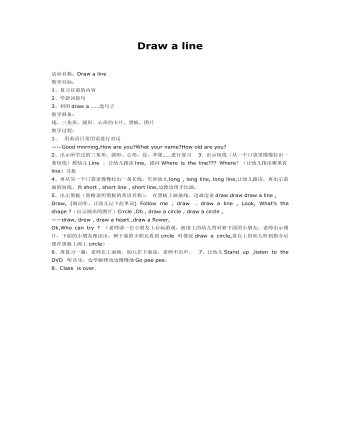
大班英语教案:Draw a line
教学目标: 1、复习以前的内容 2、学新词新句 3、利用draw a ……造句子 教学准备: 线,三角形、圆形、心形的卡片,黑板,图片 教学过程: 1、 用英语日常用语进行对话 ——Good morning,How are you?What your name?How oldare you? 2、出示所学过的三角形、圆形、心形,花,苹果……进行复习 3、出示短线(从一个口袋里慢慢拉出一条短线)教幼儿Line ,让幼儿跟读line, 提问Where is the line??? Where?(让幼儿指出哪里有line)寻找 4、再从另一个口袋里慢慢拉出一条长线,告诉幼儿long , long line, long line,让幼儿跟读,再出示前面的短线,教short , short line , shortline,边教边用手比画。
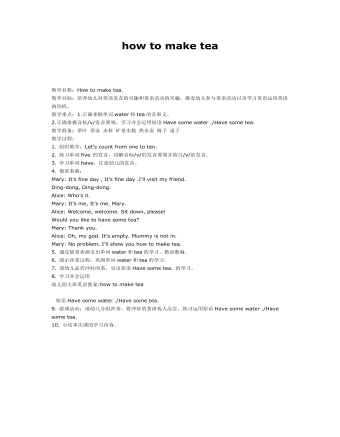
大班英语教案:how to make tea
2.正确掌握音标/v/发音要领,学习并会运用短语Have some water ./Have some tea.教学准备:茶叶茶壶水杯矿泉水瓶热水壶椅子桌子教学过程:1. 组织教学:Let’s count from one toten.2. 练习单词five 的发音,讲解音标/v/的发音要领并练习/v/的发音.3. 学习单词have,注意幼儿的发音。
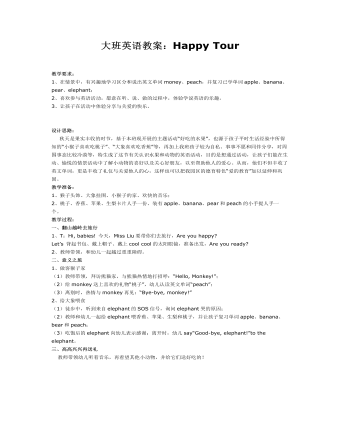
大班英语教案:Happy Tour
教学准备:1、猴子头饰、大象挂图、小猴子的家、欢快的音乐;2、桃子、香蕉、苹果、生梨卡片人手一份、装有apple、banana、pear和peach的小手提人手一个。教学过程:一、翻山越岭去旅行 1、T:Hi, babies! 今天,MissLiu要带你们去旅行,Are you happy?Let’s 背起书包、戴上帽子、戴上cool cool的太阳眼镜,准备出发,Are you ready?2、教师带领,和幼儿一起越过重重障碍。
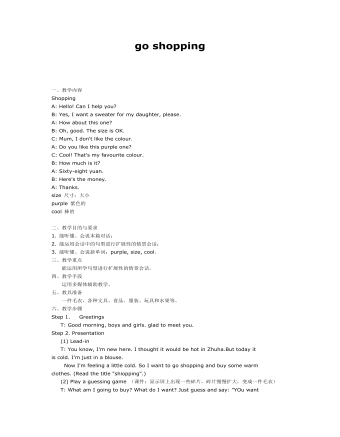
大班英语教案:go shopping
二、教学目的与要求1. 能听懂、会说本篇对话; 2. 能运用会话中的句型进行扩展性的情景会话; 3. 能听懂、会说新单词:purple, size, cool。三、教学重点 能运用所学句型进行扩展性的情景会话。四、教学手段 运用多媒体辅助教学。五、教具准备 一件毛衣,各种文具、食品、服装、玩具和水果等。
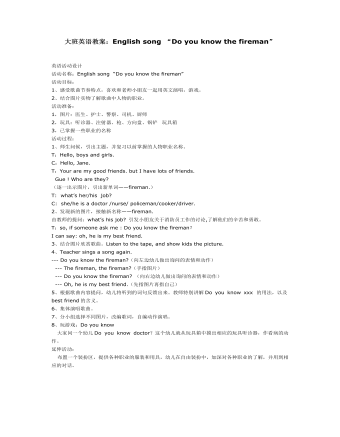
大班英语教案:English song “Do you know the fireman”
活动目标: 1、感受歌曲节奏特点,喜欢和老师小朋友一起用英文演唱,游戏。 2、结合图片实物了解歌曲中人物的职业。 活动准备: 1,图片:医生、护士、警察、司机、厨师 2,玩具:听诊器、注射器、枪、方向盘、锅铲 玩具箱 3,已掌握一些职业的名称 活动过程: 1、师生问候,引出主题,并复习以前掌握的人物职业名称。 T:Hello, boys and girls. C:Hello, Jane. T:Your are my good friends.but I have lots of friends. Gue ! Who are they? (逐一出示图片,引出新单词——fireman.) T: what’s her/his job? C: she/he is a doctor /nurse/policeman/cooker/driver.
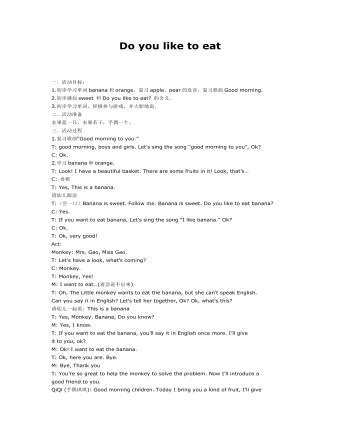
大班英语教案:Do you like to eat
二、活动准备水果蓝一只,水果若干,手偶一个。三、活动过程1.复习歌曲“Good morning to you.”T: good morning, boys and girls. Let’s sing the song“good morning to you”, Ok?C: Ok.2.学习banana和orange.T: Look! I have a beautiful basket. There are somefruits in it! Look, that’s…C: 香蕉T: Yes, This is a banana.请幼儿跟读T:(尝一口)Banana is sweet. Follow me.Banana is sweet. Do you like to eat banana?C: Yes.T: If you want to eat banana, Let’s sing the song“I like banana.” Ok?C: Ok.T: Ok, very good!Act:Monkey: Mrs. Gao, Miss Gao.T: Let’s have a look, what’s coming?C: Monkey.T: Monkey, Yes!M: I want to eat…(着急说不出来)
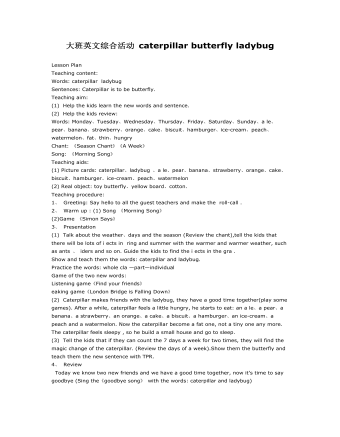
大班英语教案:caterpillar butterfly ladybug
(1) Helpthe kids learn the new words and sentence. (2) Help the kids review: Words: Monday、Tuesday、Wednesday、Thursday、Friday、Saturday、Sunday、a le、pear、banana、strawberry、orange、cake、biscuit、hamburger、ice-cream、peach、watermelon、fat、thin、hungry Chant: 《Season Chant》《A Week》 Song: 《Morning Song》 Teaching aids: (1) Picture cards: caterpillar、ladybug 、a le、pear、banana、strawberry、orange、cake、biscuit、hamburger、ice-cream、peach、watermelon (2) Real object: toy butterfly、yellow board、cotton. Teaching procedure:
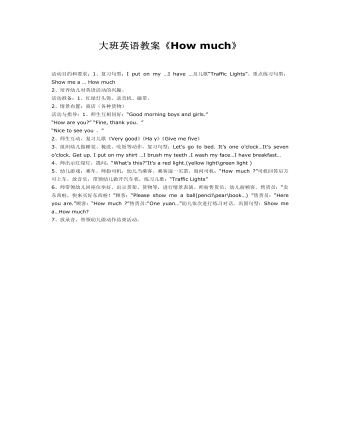
大班英语教案《How much》
2、培养幼儿对英语活动的兴趣。 活动准备:1、红绿灯头饰。录音机、磁带。 2、情景布置:商店(各种货物) 活动与指导:1、师生互相问好:“Good morning boys andgirls.” “How are you?” “Fine, thank you。” “Nice to see you 。” 2、师生互动,复习儿歌《Very good》《Ha y》《Give me five》 3、组织幼儿做睡觉、梳洗、吃饭等动作,复习句型:Let’s go to bed. It’s oneo’clock…It’s seven o’clock. Get up. I put on my shirt …I brush my teeth .I washmy face…I have breakfast…
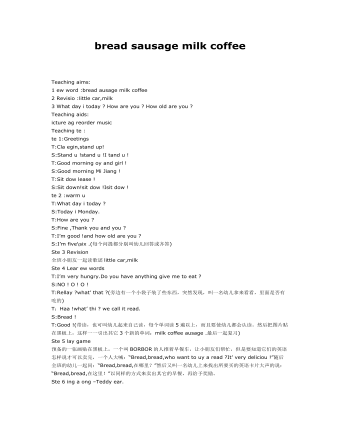
大班英语教案:bread sausage milk coffee
2 Revisio :little car,milk3 What day i today ? How are you ? How old are you ?Teaching aids:icture ag reorder musicTeaching te :te 1:GreetingsT:Cla egin,stand up!S:Stand u !stand u !I tand u !T:Good morning oy and girl !S:Good morning Mi Jiang !T:Sit dow lease !
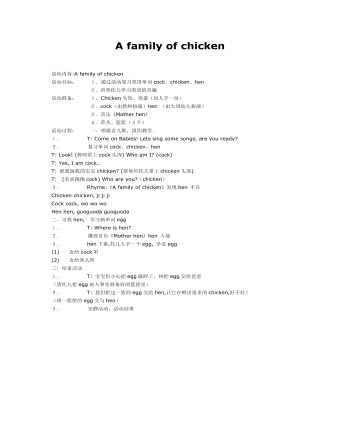
大班英语教案:A family of chicken
活动准备: 1.Chicken头饰、鸡蛋(均人手一份) 2.cock(由教师扮演)hen (由大班幼儿扮演) 3.音乐《Mother hen》 4.草丛、篮筐(2个)活动过程: 一.唱歌念儿歌,组织教学.1. T: Come on Babies! Lets sing some songs, are you ready?2. 复习单词cock、chicken、henT: Look! (教师带上cock头饰) Who am I? (cock)T: Yes, I am cock..T: 谁想做我的宝宝chicken? (帮每位托儿带上chicken头饰)T:(亲亲抱抱cock) Who are you?(chicken)3. Rhyme:《A family of chicken》发现hen 不在Chicken chicken, ji ji jiCock cock, wo wo woHen hen, guoguoda guoguoda
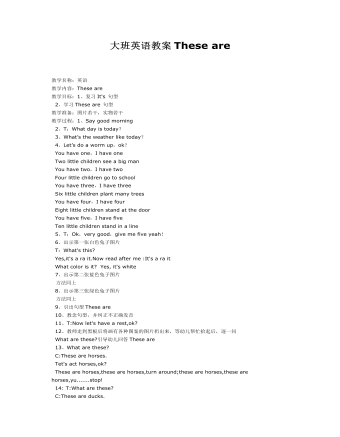
大班英语教案These are
2、学习These are 句型 教学准备:图片若干,实物若干 教学过程:1、Say good morning 2、T:What day is today? 3、What’s the weather like today? 4、Let’s do a worm up,ok? You have one,I have one Two little children see a big man You have two,I have two Four little children go to school You have three,I have three Six little children plant many trees You have four,I have four Eight little children stand at the door You have five,I have five Ten little children stand in a line
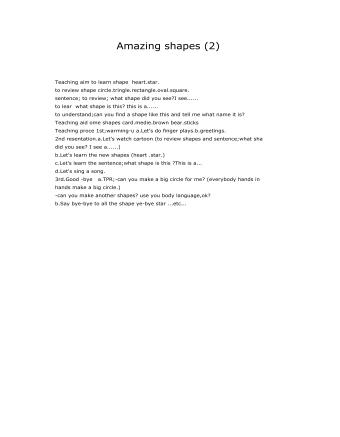
大班英语教案:Amazing shapes (2)
to review shape circle.tringle.rectangle.oval.square. sentence; to review; what shape did yousee?I see...... to lear what shape is this? this isa...... to understand;can you find a shape likethis and tell me what name it is? Teaching aid ome shapes card.medie.brownbear.sticks Teaching proce 1st;warming-u a.Let's dofinger plays.b.greetings. 2nd resentation.a.Let's watch cartoon (toreview shapes and sentence;what sha

新人教版高中英语必修3Unit 1 Festivals and celebrations-Discovering Useful Structure教学设计
4.That was an experience that frightened everyone. →That was _____________________. 答案:1. taking 2. being discussed 3. in the reading room 4. a frightening experienceStep 6 The meaning and function of V-ing as the predicative动词-ing形式作表语,它通常位于系动词后面,用以说明主语“是什么”或“怎么样”一种表示主语的特质、特征和状态, 其作用相当于形容词; 另一种具体说明主语的内容, 即主语等同于表语, 两者可互换。The music they are playing sounds so exciting. 他们演奏的音乐听起来令人激动。The result is disappointing. 结果令人失望。Our job is playing all kinds of music. 我们的工作就是演奏各种音乐。Seeing is believing. 眼见为实。Step 7 Practice1. It is ________(amaze) that the boy is able to solve the problem so quickly.2. Buying a car is simply _______(waste) money. 3. Please stop making the noise—it’s getting ________(annoy). 4. complete the passage with the appropriate -ing form.La Tomatina is a festival that takes place in the Spanish town Bunol every August. I think many food festivals are __________ because people are just eating. however, this festival is _________ because people don't actually eat the tomatoes. Instead, they throw them at each other! the number of people ________ part in this tomato fight, can reach up to 20,000, and it is a very __________ fight that lasts for a whole hour. The _______ thing is how clean Bunol is after the tomatoes are washed away after the fight. this is because the juice form tomatoes is really good for making surfaces clean!答案:1. amazing 2. wasting 3. annoying4. boring interesting taking exciting amazing

新人教版高中英语必修3Unit 1 Festivals and Celebrations-Reading and Thinking教学设计
The topic of this part is “Discover the reasons for festivals and celebrations.The Listening & Speaking & Talking part aims at talking about the experiences and feelings or emotions about the festivals and celebrations. This section aims at detecting the reason why the people celebrate the festivals, the time, the places, the types and the way of celebrations. It also explains why some traditions in the old celebrations are disappearing, like the firecrackers in the big cities and some new things are appearing like the prosperity of business or commerce. 1. Students can talk about what festivals they know and the reasons and the way of celebrating them.2. Students should learn the reading skills such as the headline and get the topic sentences, the structures of articles.3. Students can understand the past, the present situation of some festival around the world and why there are some changes about them. 4. Students can have the international awareness about the festivals.1. Students should learn the reading skills such as the headline and get the topic sentences, the structures of articles.2. Students can understand the past, the present situation of some festival around the world and why there are some changes about them.Step 1 Lead in---Small talkWhat festival do you like best ? Why ?I like the Spring Festivals because I can set off the fireworks, receive the lucky money and enjoy the Gala with my families.Step 2 Before reading---Pair workWhy do people celebrate different festivals ?The Spring Festivals is to celebrate the end of winter and the coming of spring and new life.The Mid-autumn Day is to celebrate the harvest and admire the moon.

新人教版高中英语必修3Unit 1 Festivals and Celebrations-Reading for writing教学设计二
Step 3 Analyzing article structureActivity 31. Teachers raise questions to guide students to analyze the chapter structure of this diary and think about how to describe the festival experience. (1)What should be included in the opening/body/closing paragraph(s)?(2)How did the writer arrange his/her ideas?(3)What kind of interesting details did the writer describe?(4)How did the writer describe his/her feelings/emotions during the event?2. Students read and compare the three sentence patterns in activity 2. Try to rewrite the first paragraph of the diary with these three sentence patterns. After that, students exchange corrections with their partners. Such as:●This was my first time spending three days experiencing the Naadam Festival in China’s Inner Mongolia Autonomous Region and it was an enjoyable and exciting experience. ●I'll never forget my experience at the Naadam Festival because it was my first time to watch the exciting Mongolian games of horse racing, wrestling, and archery so closely. ●I'll always remember my first experience at the Naadam Festival in China’s Inner Mongolia Autonomous Region because it was so amazing to spend three days witnessing a grand Mongolian ceremony. Step 4 Accumulation of statementsActivity 41. Ask the students to read the diary again. Look for sentences that express feelings and emotions, especially those with the -ing form and the past participle. Such as:● …horse racing, wrestling, and archery, which are all so exciting to watch. ● some amazing performances● I was surprised to see…● I was a little worried about. . . ● feeling really tiredOther emotional statements:●I absolutely enjoyed the archery, too, but the horse races were my favourite part. ●I'm finally back home now, feeling really tired, but celebrating Naadam with my friend was totally worth it. ●He invited me back for the winter to stay in a traditional Mongolian tent and cat hot pot. I can’t wait!2. In addition to the use of the -ing form and the past participle, the teacher should guide the students in the appreciation of these statements, ask them to memorize them, and encourage them to use them reasonably in writing practice.

新人教版高中英语必修3Unit 1 Festivals and Celebrations-Reading for Writing教学设计一
The topic of this part is “Write about your festival experience”.During the Listening and Speaking and Talking, students are just asked to say out their festival experiences such as the Spring Festival, Mid-autumn Day, but this part students will be asked to write down their own festival experiences. During the reading part, it introduces the Naadam Festival in Inner Mongolia Autonomous Region, which can give students a good example to imitate. Students not only learn the festival, but touch and feel the Inner Mongolian’s character, the spirit and cultural atmosphere, which can help students form the cultural awareness and learn to enjoy and value the diversity of Chinese culture.Concretely, the dairy tells the experience that the author spent the Naadam Festival in Inner Mongolia Autonomous Region with his/her friend. The structure is clear. In the opening paragraph, it introduces the topic of the Naadam Festival and the whole feeling. Then it introduces the items of the festival like the ceremony, wrestling and horse racing. Finally, it summarizes this experience. Because this part is a travel journal, we must guide students pay more attention to these details: 1. use the first person. 2. use the past tense to tell the past thing and use the present or future tense to describe the scenery. 3. use the timeline to tell the development. 4. be careful for the author’s psychology, emotion and feeling, etc.1. Read quickly to get main idea; read carefully to get the detailed information about Naadam Festival.2. Learn the structure of the reading article and language.3. Write an article about a festival experience4. Learn to use the psychology, emotions and feeling in the writing.1. Write an article about a festival experience.2. Use the structure of the reading article and language.

新人教版高中英语必修3Unit 2 Morals and Virtues-Discovering Useful Structure教学设计
1. 表示时间。Hearing these stories, I’m skeptical about the place. = When I heard these stories. . . 2. 表示原因。Not knowing his address, I can’t send this book to him. = Because/Since/As I don’t know his address. . . 3. 表示结果。His father died, leaving him a lot of money. =. . . and left him a lot of money4. 表示条件。Going straight down the road, you will find the department store. = If you go straight down the road. . . 5. 表示让步。Being tired, they went on working. =Although they were tired. . . 6. 表示行为方式、伴随情况或补充说明。He lay on the grass, staring at the sky for a long time. =. . . and stared at the sky for a long time注意:非谓语动词作状语时, 如所提供的动词不能和句子中的主语保持一致, 动词-ing形式必须有自己的逻辑主语, 通常由名词或代词来担任, 这就是独立主格结构。The last bus having gone, we had to walk home. (having gone的逻辑主语是the last bus, 而不是we)Weather permitting, the football match will be played on Friday. (permitting的逻辑主语是time, 而不是the football match)Step 7 Practice1. ________(study) hard, you are sure to get first prize. 2. People use plastic in their daily life, _______(leave) large amounts of waste. 3. ________(work) hard at your lessons, you are to succeed. 4. The old man, ____________(work) abroad for twenty years, is on the way back to his motherland. 5. ______________(finish) his homework, he was playing on the playground. Answers: 1. Studying 2. leaving 3. Working 4.having worked 5. Having finishedStep 8 HomeworkFinish the homework on Page 22.
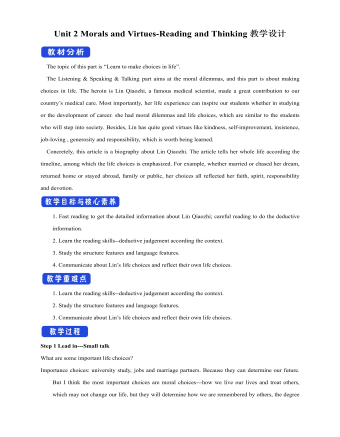
新人教版高中英语必修3Unit 2 Morals and Virtues-Reading and Thinking教学设计
The topic of this part is “Learn to make choices in life”.The Listening & Speaking & Talking part aims at the moral dilemmas, and this part is about making choices in life. The heroin is Lin Qiaozhi, a famous medical scientist, made a great contribution to our country’s medical care. Most importantly, her life experience can inspire our students whether in studying or the development of career. she had moral dilemmas and life choices, which are similar to the students who will step into society. Besides, Lin has quite good virtues like kindness, self-improvement, insistence, job-loving , generosity and responsibility, which is worth being learned.Concretely, this article is a biography about Lin Qiaozhi. The article tells her whole life according the timeline, among which the life choices is emphasized. For example, whether married or chased her dream, returned home or stayed abroad, family or public, her choices all reflected her faith, spirit, responsibility and devotion.1. Fast reading to get the detailed information about Lin Qiaozhi; careful reading to do the deductive information.2. Learn the reading skills--deductive judgement according the context.3. Study the structure features and language features. 4. Communicate about Lin’s life choices and reflect their own life choices.1. Learn the reading skills--deductive judgement according the context.2. Study the structure features and language features.3. Communicate about Lin’s life choices and reflect their own life choices.Step 1 Lead in---Small talkWhat are some important life choices?Importance choices: university study, jobs and marriage partners. Because they can determine our future.
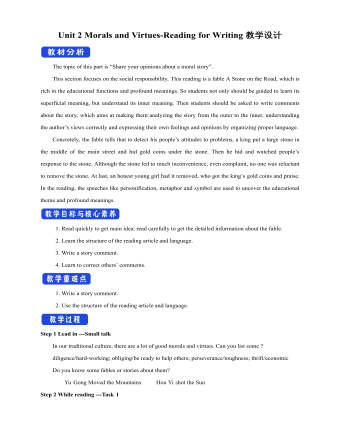
新人教版高中英语必修3Unit 2 Morals and Virtues-Reading for Writing教学设计
1. 这个寓言是一个关于一位国王古寓言。 The fable is an old fable about a king.2.作者用这个故事让读者对于社区的问题负有个人责任的必要印象深刻。The author used the story to impress upon readers with the need to take personal responsibility for problems in the community.3. 这个故事十分成功的实现了它的目的。The story was quite successful in achieving its purpose.Step 7 WritingPlease write a review of the story according the outline above.The fable is an old fable about a king who thought his people are lazy, so he put a large stone in the middle of the road and hides and waited to see if anyone will try to move it.The author used this story to impress upon readers with the need to take personal responsibility for problems in the community. The story was quite successful in achieving its purpose, and I liked it because it had a clear moral.However, while the moral of the story is clear, the actions of the king seemed pointless to me, because none of the characters in the story learnt anything. For this reason, I think there are better stories that can be used to impress upon people with the need for personal responsibility.Step 8 Pair workExchange drafts with a partner. Use this checklist to help your partner revise his/her draft.1. Does the writer give a short description of the story ?2. Does the description include the most important details of the story ?3. Does the writer give his or her opinion about the character or their actions ?4. Is the review well-organised ? 5. Does the writer use the -ing form as the adverbial correctly in the writing ?6. Are there any grammar, spelling, or punctuation errors ?Step 9 HomeworkPut up your revised draft in the classroom or read it to your class.